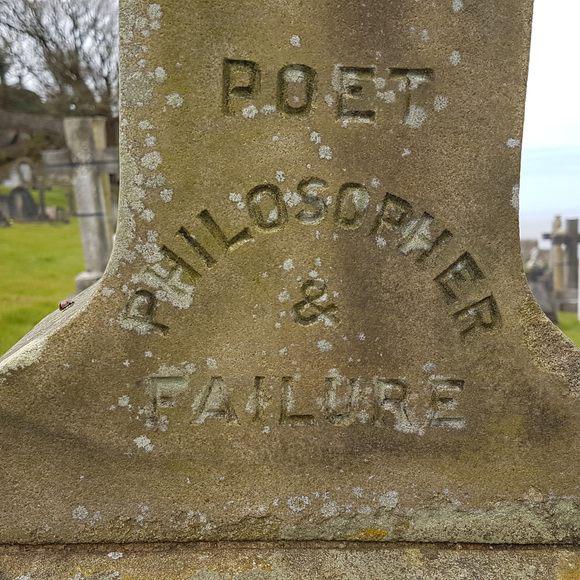
This stone, behind St. Peter’s Church in Heysham, Lancashire, commemorates the lives of James Jones and his two wives, Sarah and Sadie.
Which of them earned this epithet, and how, is not clear.
(Thanks, Dave.)

This stone, behind St. Peter’s Church in Heysham, Lancashire, commemorates the lives of James Jones and his two wives, Sarah and Sadie.
Which of them earned this epithet, and how, is not clear.
(Thanks, Dave.)
Austrian artist Thomas Medicus’ 2014 anamorphic sculpture Emulsifier arranges 160 hand-painted glass strips to present each of four different images, depending on the viewer’s perspective.
Head Instructor, below, uses the same technique. More at his website.
Anna Rabinowitz’s 80-page poem Darkling is an acrostic of Thomas Hardy’s 1900 poem “The Darkling Thrush” — taking the first letter of each line in Rabinowitz’s poem spells out Hardy’s.
“I found myself … haunted by ‘The Darkling Thrush,'” she said, “by its tone of millennial mourning, by its note of hope in the thrush’s song, and most especially by its opening line which situates the poet at he meditates on the passing century: ‘I leant upon a coppice gate.'”
A million million spermatozoa,
All of them alive;
Out of their cataclysm but one poor Noah
Dare hope to survive.
And among that billion minus one
Might have chanced to be
Shakespeare, another Newton, a new Donne —
But the One was Me.
Shame to have ousted your betters thus,
Taking ark while the others remained outside!
Better for all of us, froward Homunculus,
If you’d quietly died!
— Aldous Huxley
From an old copy of Games magazine:
Four players describe the cards they held in their last game of five-card poker:
Harry: “I had the two, nine, and jack of hearts, and the two and nine of diamonds.”
Edna: “I held four fives and the queen of spades.”
Dave: “I had a black straight flush.”
Frankie: “I held a club flush.”
Georgiana: “I had a straight. Two of my cards were spades; the others weren’t.”
Cleo: “I just had one lousy pair.” (to Frankie:) “But my lowest-ranking card was higher than any of yours.”
An onlooker asks how many of the undealt cards were black, and Dave answers, “No more than three.” What were the contents of Dave’s, Frankie’s, Georgiana’s, and Cleo’s hands?
A puzzle by National Security Agency mathematician David B., from the agency’s October 2017 Puzzle Periodical:
Joey, the baby kangaroo has been kidnapped and placed at 2100 on a number line.
His mother, Kandice the Kangaroo, is at 0 on the number line, and will try to save him. Kandice normally jumps forward 6 units at a time. Guards have been placed at n3 on the number line, for every integer n≥1. If Kandice lands on a number with a guard on it, she will be caught and her mission will fail. Otherwise, she will safely sneak past the guard. Whenever she successfully sneaks past a guard, she gets an adrenaline rush that causes her next jump (the first jump after passing the guard) to take her 1 unit farther than it normally would (7 units instead of 6). (After a single 7-unit jump, she resumes jumping 6 units at a time, until the next time she sneaks past a guard.)
Will Kandice the Kangaroo reach (or pass) her son Joey safely?
A Philosopher seeing a Fool beating his Donkey, said:
‘Abstain, my son, abstain, I implore. Those who resort to violence shall suffer from violence.’
‘That,’ said the Fool, diligently belaboring the animal, ‘is what I’m trying to teach this beast — which has kicked me.’
‘Doubtless,’ said the Philosopher to himself, as he walked away, ‘the wisdom of fools is no deeper nor truer than ours, but they really do seem to have a more impressive way of imparting it.’
— Ambrose Bierce, Fantastic Fables, 1899
A note sent by Mark Twain’s American traveling companion to his French landlord, 1867:
PARIS, le 7 Juillet. Monsieur le Landlord — Sir: Pourquoi don’t you mettez some savon in your bed-chambers? Est-ce que vous pensez I will steal it? La nuit passee you charged me pour deux chandelles when I only had one; hier vous avez charged me avec glace when I had none at all; tout les jours you are coming some fresh game or other on me, mais vous ne pouvez pas play this savon dodge on me twice. Savon is a necessary de la vie to any body but a Frenchman, et je l’aurai hors de cet hotel or make trouble. You hear me. Allons. BLUCHER.
“I remonstrated against the sending of this note, because it was so mixed up that the landlord would never be able to make head or tail of it; but Blucher said he guessed the old man could read the French of it and average the rest.”
(From The Innocents Abroad.)
A problem by G. Galperin, from the May-June 1995 issue of Quantum:
A raft and a motorboat depart simultaneously from Point A on a riverbank and begin drifting and speeding downstream, respectively, toward Point B. At the same moment, a second motorboat, of the same type as the first, sets out from Point B heading upstream. When the first motorboat reaches B, will the floating raft be closer to Point A or to the second motorboat?
George Orwell’s six rules of writing, from “Politics and the English Language,” 1946:
But “one could keep all of them and still write bad English.”